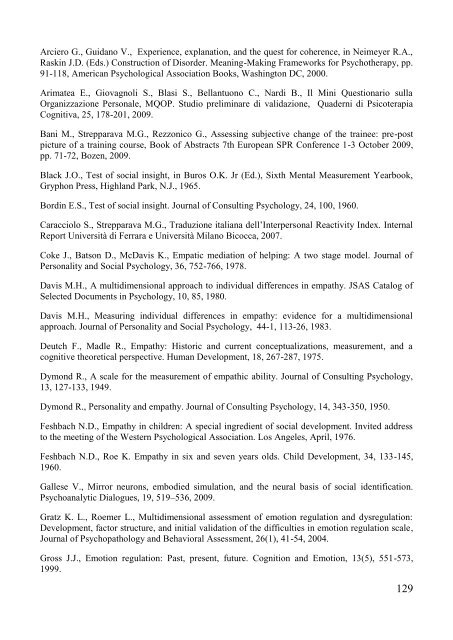“Lavorare con le emozioni” – Il volume raccoglie i contributi originali
“Lavorare con le emozioni” – Il volume raccoglie i contributi originali
“Lavorare con le emozioni” – Il volume raccoglie i contributi originali
You also want an ePaper? Increase the reach of your titles
YUMPU automatically turns print PDFs into web optimized ePapers that Google loves.
Arciero G., Guidano V., Experience, explanation, and the quest for coherence, in Neimeyer R.A.,<br />
Raskin J.D. (Eds.) Construction of Disorder. Meaning-Making Frameworks for Psychotherapy, pp.<br />
91-118, American Psychological Association Books, Washington DC, 2000.<br />
Arimatea E., Giovagnoli S., Blasi S., Bellantuono C., Nardi B., <strong>Il</strong> Mini Questionario sulla<br />
Organizzazione Persona<strong>le</strong>, MQOP. Studio preliminare di validazione, Quaderni di Psicoterapia<br />
Cognitiva, 25, 178-201, 2009.<br />
Bani M., Strepparava M.G., Rezzonico G., Assessing subjective change of the trainee: pre-post<br />
picture of a training course, Book of Abstracts 7th European SPR Conference 1-3 October 2009,<br />
pp. 71-72, Bozen, 2009.<br />
Black J.O., Test of social insight, in Buros O.K. Jr (Ed.), Sixth Mental Measurement Yearbook,<br />
Gryphon Press, Highland Park, N.J., 1965.<br />
Bordin E.S., Test of social insight. Journal of Consulting Psychology, 24, 100, 1960.<br />
Caracciolo S., Strepparava M.G., Traduzione italiana dell’Interpersonal Reactivity Index. Internal<br />
Report Università di Ferrara e Università Milano Bicocca, 2007.<br />
Coke J., Batson D., McDavis K., Empatic mediation of helping: A two stage model. Journal of<br />
Personality and Social Psychology, 36, 752-766, 1978.<br />
Davis M.H., A multidimensional approach to individual differences in empathy. JSAS Catalog of<br />
Se<strong>le</strong>cted Documents in Psychology, 10, 85, 1980.<br />
Davis M.H., Measuring individual differences in empathy: evidence for a multidimensional<br />
approach. Journal of Personality and Social Psychology, 44-1, 113-26, 1983.<br />
Deutch F., Mad<strong>le</strong> R., Empathy: Historic and current <strong>con</strong>ceptualizations, measurement, and a<br />
cognitive theoretical perspective. Human Development, 18, 267-287, 1975.<br />
Dymond R., A sca<strong>le</strong> for the measurement of empathic ability. Journal of Consulting Psychology,<br />
13, 127-133, 1949.<br />
Dymond R., Personality and empathy. Journal of Consulting Psychology, 14, 343-350, 1950.<br />
Feshbach N.D., Empathy in children: A special ingredient of social development. Invited address<br />
to the meeting of the Western Psychological Association. Los Ange<strong>le</strong>s, April, 1976.<br />
Feshbach N.D., Roe K. Empathy in six and seven years olds. Child Development, 34, 133-145,<br />
1960.<br />
Gal<strong>le</strong>se V., Mirror neurons, embodied simulation, and the neural basis of social identification.<br />
Psychoanalytic Dialogues, 19, 519<strong>–</strong>536, 2009.<br />
Gratz K. L., Roemer L., Multidimensional assessment of emotion regulation and dysregulation:<br />
Development, factor structure, and initial validation of the difficulties in emotion regulation sca<strong>le</strong>,<br />
Journal of Psychopathology and Behavioral Assessment, 26(1), 41-54, 2004.<br />
Gross J.J., Emotion regulation: Past, present, future. Cognition and Emotion, 13(5), 551-573,<br />
1999.<br />
129



